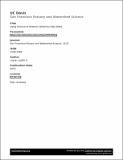| dc.contributor.author | Layzer, Judith A. | |
| dc.date.accessioned | 2020-04-21T19:43:16Z | |
| dc.date.available | 2020-04-21T19:43:16Z | |
| dc.date.issued | 2013-10 | |
| dc.identifier.issn | 1546-2366 | |
| dc.identifier.uri | https://hdl.handle.net/1721.1/124771 | |
| dc.description.abstract | The State of California and the U.S. Department of Interior have committed to relying on science as a guide to both restoring the Bay–Delta ecosystem and deciding how much water can be exported from that system. In theory, upholding this commitment should be straightforward. In practice, however, figuring out how science can and should guide policymaking is challenging when the problem at hand is complex and multifaceted, and features a cast of savvy, powerful stakeholders with sharply different interests. One reason is that participants in such controversies have long used debates over science as proxies for debates over values. The conflict over the Bay– Delta is no different; recently, for example, representatives of large-scale water users dismissed the suggestion that too much water is being exported from the Bay–Delta system, although more than three-quarters of the scientists surveyed by the Public Policy Institute of California (PPIC) believe that excessive water withdrawals pose a problem (Anonymous 2013). To make progress in this situation, state and federal policymakers should take a series of bold steps. ©2013 [Introductory paragraphs] | en_US |
| dc.language.iso | en | |
| dc.publisher | San Francisco Estuary and Watershed Science | en_US |
| dc.relation.isversionof | 10.15447/SFEWS.2013V11ISS3ART3 | en_US |
| dc.rights | Creative Commons Attribution 4.0 International license | en_US |
| dc.rights.uri | https://creativecommons.org/licenses/by/4.0/ | en_US |
| dc.source | San Francisco Estuary & Watershed Science | en_US |
| dc.title | Using Science to Restore California's Bay-Delta | en_US |
| dc.type | Article | en_US |
| dc.identifier.citation | Layzer, Judith A., "Using Science to Restore California's Bay-Delta." San Francisco Estuary and Watershed Science 11, 3 (October 2013): doi 10.15447/SFEWS.2013V11ISS3ART3 ©2013 Author(s) | en_US |
| dc.contributor.department | Massachusetts Institute of Technology. Department of Urban Studies and Planning | en_US |
| dc.relation.journal | San Francisco Estuary and Watershed Science | en_US |
| dc.eprint.version | Final published version | en_US |
| dc.type.uri | http://purl.org/eprint/type/JournalArticle | en_US |
| eprint.status | http://purl.org/eprint/status/PeerReviewed | en_US |
| dc.date.updated | 2019-05-10T12:14:39Z | |
| dspace.date.submission | 2019-05-10T12:14:42Z | |
| mit.journal.volume | 11 | en_US |
| mit.journal.issue | 3 | en_US |
| mit.metadata.status | Complete | |
